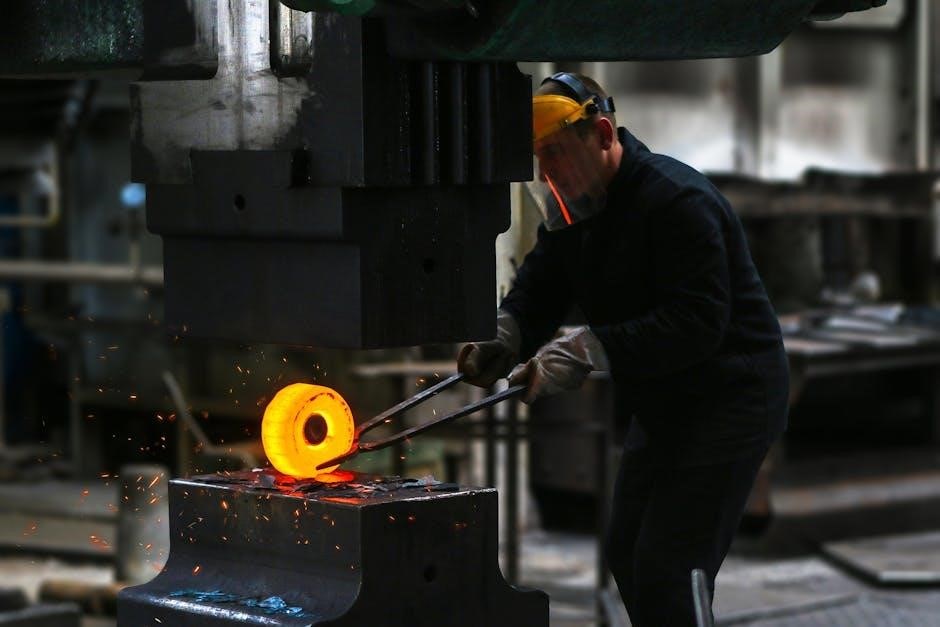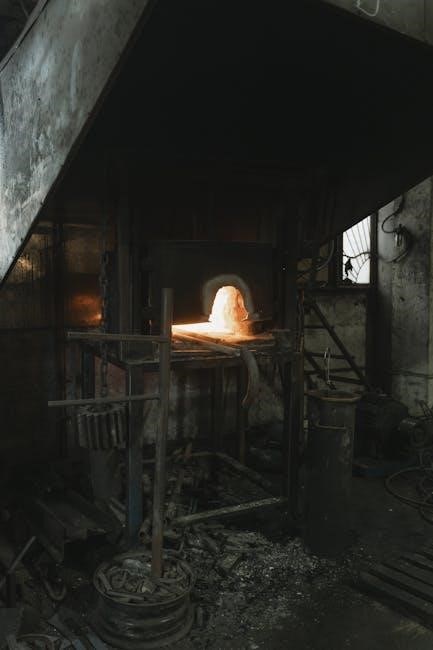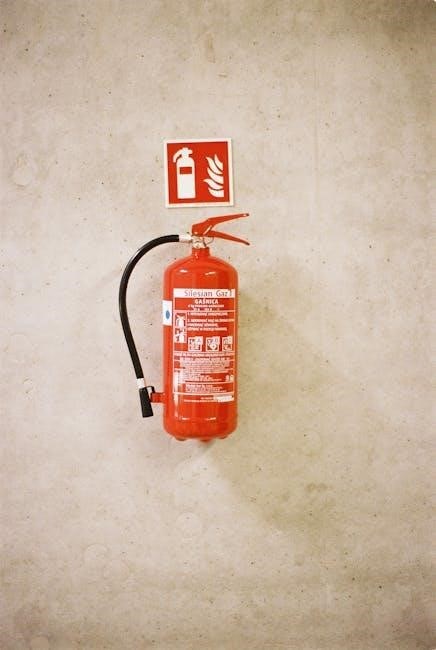Fire Alarm Manual: A Comprehensive Guide
This manual provides essential guidance on fire alarm systems, covering types, standards like BS 5839 and NFPA 72, and rules for manufacturers and installations․
Understanding these systems—from conventional to wireless—is crucial for life and property protection, alongside false alarm reduction strategies․
Fire alarm systems are vital components of building safety, designed to detect and alert occupants to the presence of fire, facilitating safe evacuation and minimizing potential damage․ These systems aren’t simply about compliance; they represent a proactive approach to safeguarding life, property, and valuable assets․
A comprehensive understanding of these systems is paramount for building owners, facility managers, and anyone responsible for fire safety․ This includes recognizing the diverse types available – from conventional and monitored systems to advanced wireless and aspirating technologies like Notifier systems․
Effective operation relies heavily on adherence to established standards, notably BS 5839 in the UK and NFPA 72 in the US, which dictate installation, maintenance, and testing procedures․ Regular upkeep isn’t merely recommended; it’s essential to ensure full operational capability when needed most․
Importance of Regular Maintenance

Regular maintenance of fire alarm systems isn’t simply a best practice; it’s a critical necessity for ensuring reliable performance when lives and property are at stake․ Systems are expected to function flawlessly during emergencies, but this capability isn’t guaranteed without consistent care and inspection․
Neglecting maintenance can lead to component failures, reduced sensitivity, and ultimately, system malfunction․ This compromises the system’s ability to provide timely warnings, potentially resulting in delayed evacuation and increased damage․ A seemingly functional system can quickly become ineffective without routine checks․
Proactive maintenance, adhering to standards like NFPA 72, includes regular testing of detectors, control panels, and notification appliances․ It also encompasses thorough inspections of wiring and power supplies․ Maintaining operational systems isn’t about visibility; it’s about verified functionality and preparedness․
Understanding Fire Alarm System Types
Fire alarm systems aren’t one-size-fits-all; they come in various types, each suited to different needs and environments․ Conventional fire alarms divide buildings into zones, identifying the general area of a fire but not the precise location․ Monitored fire alarms connect to a central station, providing 24/7 surveillance and automatic dispatch of emergency services․
Wireless fire alarms offer flexibility and ease of installation, ideal for retrofits or buildings where wiring is difficult․ Notifier fire alarm systems are known for their advanced features and reliability, often used in complex facilities․ Aspirating fire alarm systems detect smoke particles before they become visible, offering very early warning․
Choosing the right system depends on factors like building size, occupancy, and risk assessment․ Understanding the strengths and limitations of each type is crucial for effective fire protection․
Conventional Fire Alarm Systems
Conventional fire alarm systems represent a foundational approach to fire detection, dividing a building into distinct zones․ Each zone contains multiple detectors wired to a central control panel․ When a detector activates, the panel indicates which zone has a fire, but not the specific device triggered․
These systems are generally more cost-effective than addressable systems, making them suitable for smaller buildings or specific areas within larger facilities․ Installation is relatively straightforward, and they are known for their reliability․ However, pinpointing the exact fire location requires manual investigation within the alerted zone․
Conventional systems utilize a simpler wiring configuration, simplifying maintenance and troubleshooting․ They are a practical choice where precise location identification isn’t paramount, offering essential fire protection at a reasonable cost․
Monitored Fire Alarm Systems
Monitored fire alarm systems elevate fire protection by connecting to a professional monitoring center․ When an alarm is triggered, the monitoring center receives a signal and immediately attempts to verify the emergency, often by contacting the premises․ If a fire is confirmed, they dispatch the fire department, regardless of whether someone is on-site․
This 24/7 monitoring provides crucial peace of mind, especially for unoccupied buildings or during off-hours․ It significantly reduces response times, potentially minimizing damage and saving lives․ These systems often incorporate various communication methods, including cellular, internet, and traditional phone lines, ensuring reliable signal transmission․
Monitored systems typically involve a monthly fee for the monitoring service, but the added security and rapid response capabilities make it a worthwhile investment for many businesses and homeowners․
Wireless Fire Alarm Systems
Wireless fire alarm systems offer a flexible and cost-effective alternative to traditional wired systems, particularly in buildings where running cables is difficult or impractical․ These systems utilize radio frequency (RF) communication to transmit signals between detectors, control panels, and monitoring centers․
Installation is typically faster and less disruptive than wired systems, making them ideal for renovations or historic buildings․ Modern wireless technology ensures reliable signal transmission and minimizes interference․ Battery-powered detectors eliminate the need for wiring, simplifying installation and reducing costs․

Innovations in wireless fire safety, like those from Dubai-based specialists bringing UK systems to the Middle East, demonstrate increasing safety standards․ Regular battery checks and system testing are crucial for maintaining the reliability of these systems․
Notifier Fire Alarm Systems
Notifier, a leading manufacturer of fire alarm systems, offers a comprehensive range of solutions designed for diverse applications, from small commercial buildings to large, complex facilities․ Their systems are known for their scalability, reliability, and advanced features, including intelligent detection and addressable devices․
Notifier systems often incorporate sophisticated control panels, voice evacuation capabilities, and integration with building management systems․ These systems are designed to meet stringent industry standards, ensuring compliance with regulations and providing robust fire protection․

Proper installation and maintenance, adhering to NFPA 72 standards, are critical for optimal performance; Regular inspections, testing, and programming updates are essential to ensure the system functions correctly during an emergency․ Notifier provides extensive resources and training for installers and technicians․
Aspirating Fire Alarm Systems
Aspirating smoke detection represents a highly sensitive and proactive approach to fire protection․ Unlike conventional systems relying on smoke reaching detectors, these systems continuously draw air samples from protected areas through a network of tubing․
The sampled air is analyzed within a central detection unit, capable of identifying even minute traces of smoke particles, providing very early warning of potential fires․ This technology is particularly beneficial in environments where rapid fire development is a concern or where conventional detection may be compromised․

Installation requires careful planning of tubing layout and consideration of airflow dynamics․ Maintenance involves regular filter replacement and system testing to ensure optimal performance․ These systems often align with BS 5839 Category L1 requirements for maximum life protection․
British Standards: BS 5839 Categories
BS 5839 is the cornerstone of fire detection and alarm systems in the UK, outlining various categories based on risk assessment and protection goals․ These categories dictate the level of system sophistication and coverage required for different premises․
The standard categorizes systems into Manual (M), Life Protection (L), and Property Protection (P)․ Category M relies solely on manual call points, while Category L prioritizes life safety, with sub-categories L1 (maximum protection), L2 (additional protection), and L3 (standard protection)․
Category P focuses on minimizing property damage․ Selecting the appropriate category is crucial, determined by a thorough fire risk assessment․ Compliance with BS 5839 ensures a robust and reliable fire alarm system, safeguarding lives and assets, and is often a legal requirement․
Category M: Manual Fire Alarm Systems
Category M systems, as defined by BS 5839, represent the most basic level of fire protection, relying entirely on manual operation․ These systems consist solely of manual call points (MCPs) strategically located throughout the premises, requiring individuals to physically activate them upon discovering a fire․
This category is typically suitable for very low-risk properties, such as small, single-occupancy buildings with readily accessible exits and a high level of staff training․ Category M systems offer no automatic fire detection, meaning a fire must be visually identified before an alarm can be raised․
Due to their reliance on human intervention, Category M systems are not recommended for complex or high-occupancy buildings․ Regular inspection and testing of MCPs are vital to ensure their functionality and reliability, as they are the sole means of initiating an alarm․
Category L: Life Protection Systems
Category L fire alarm systems, governed by BS 5839, prioritize the safety of building occupants through early fire detection and warning․ Unlike Category M, these systems incorporate automatic fire detectors – such as smoke, heat, and flame detectors – alongside manual call points, providing a more comprehensive level of protection;
Category L systems are designed to give occupants sufficient warning to evacuate safely, regardless of whether a fire is discovered by a person or automatically detected․ This makes them suitable for a wide range of buildings, including offices, shops, and residential properties․
Within Category L, further subdivisions – L1, L2, and L3 – define varying levels of life protection, with L1 offering the highest degree of protection through comprehensive detection coverage and enhanced system features․
Category L1: Maximum Life Protection
Category L1 represents the highest level of life protection within the BS 5839 standard for fire alarm systems․ These systems are meticulously designed to provide the earliest possible warning of a fire, ensuring occupants have ample time to evacuate safely, even those with mobility impairments․
L1 systems mandate comprehensive fire detection throughout the entire building, including all areas – even those with low fire risk․ This includes detection in concealed spaces, such as above suspended ceilings and within ventilated voids, maximizing the chances of early fire detection․
Furthermore, Category L1 systems often incorporate advanced features like voice alarm systems, phased evacuation procedures, and firefighter lift control, enhancing both occupant safety and fire service operations․ They are typically recommended for high-risk buildings like hospitals and care homes․
Category L2: Additional Life Protection

Category L2 fire alarm systems, as defined by BS 5839, offer a significant degree of life protection, though slightly less comprehensive than Category L1․ These systems aim to provide early warning and facilitate safe evacuation, but with some concessions regarding detection coverage․
L2 systems require fire detection in all common areas, escape routes, and areas presenting a high fire risk․ However, detection in all rooms isn’t mandatory, unlike L1․ This makes them suitable for buildings where a full L1 system isn’t deemed necessary or cost-effective․
While voice alarm systems aren’t always required, Category L2 systems often include manual call points throughout the building, allowing occupants to raise an alarm․ They represent a balanced approach between comprehensive protection and practical implementation, commonly found in offices and retail spaces․
Category L3: Standard Life Protection
Category L3 fire alarm systems, outlined in BS 5839, represent a standard level of life protection, focusing on providing a reasonable degree of warning in the event of a fire․ This system is often chosen for buildings where a more comprehensive system, like Category L1 or L2, isn’t considered essential․
L3 systems mandate fire detection in common areas, escape routes – including corridors and stairwells – and a representative sample of higher-risk rooms․ However, detection isn’t required in all rooms, offering a cost-effective solution while still providing crucial protection․
Manual call points are a key component of Category L3 systems, enabling occupants to manually initiate an alarm․ These systems are frequently implemented in smaller commercial buildings, shops, and some residential properties, balancing safety with budgetary constraints and offering a foundational level of fire safety․
Category P: Property Protection Systems
Category P fire alarm systems, as defined by BS 5839, prioritize the protection of property and assets, rather than focusing primarily on life safety․ These systems are typically deployed in locations where minimizing damage from fire is the primary concern, such as warehouses, industrial units, and unoccupied buildings․
Unlike Category L systems, Category P doesn’t necessarily require comprehensive coverage throughout the building․ Detection is strategically placed in areas most vulnerable to fire ignition or where valuable assets are stored, offering targeted protection․
Automatic fire detection, coupled with a connection to a monitoring station, is common in Category P systems, ensuring a rapid response from the fire service․ While life safety features may be present, they aren’t the primary design consideration, making this category suitable for properties with limited occupancy or specific protection needs․
NFPA 72 Standards and Regulations
NFPA 72, the National Fire Alarm and Signaling Code, establishes comprehensive standards for the design, installation, testing, and maintenance of fire alarm systems in the United States․ It’s a crucial document for ensuring reliable fire protection and is regularly updated to reflect advancements in technology and best practices․

This code covers a wide range of topics, including system components, wiring methods, notification appliance requirements, and inspection procedures; Adherence to NFPA 72 is often mandated by local authorities having jurisdiction (AHJs) and is essential for code compliance․
Article 760, a specific section within NFPA 72, details the requirements for wiring and equipment installation․ Understanding and implementing these standards is vital for qualified fire alarm technicians and installers, guaranteeing a safe and effective system operation․ Regular updates and interpretations are available from NFPA․

Article 760: Wiring and Equipment Installation
Article 760 of the National Electrical Code (NEC) specifically addresses the installation of wiring and equipment utilized in fire alarm systems․ It outlines detailed requirements for circuit integrity, conductor types, and installation methods to ensure reliable operation during a fire event․ This article is paramount for safeguarding the system’s functionality when it’s needed most․
Notably, Article 760 does not cover residential smoke alarm systems․ These systems, including interconnected wiring, fall under different regulations due to their distinct scope and application․ The focus of Article 760 remains firmly on the more complex systems found in commercial and larger residential settings․
Proper adherence to Article 760 necessitates qualified personnel, utilizing approved materials, and meticulous documentation․ Ignoring these guidelines can lead to system failures, code violations, and potentially, compromised life safety․ Regular inspections verify compliance and maintain system integrity․
False Alarm Reduction and Management
False alarms represent a significant challenge for fire departments and building owners alike․ In 2003, US fire departments responded to over 2․1 million false alarms, diverting crucial resources from genuine emergencies․ Effective reduction strategies are therefore essential for public safety and cost efficiency․
Management begins with proper system design, installation, and regular maintenance․ Addressing common causes – dust, insects, cooking fumes, and mechanical failures – is paramount․ Sensitivity adjustments, coupled with thorough testing, can minimize nuisance activations․
Furthermore, implementing robust verification protocols, such as two-stage activation, can confirm the legitimacy of an alarm before dispatching emergency services․ Comprehensive staff training on alarm system operation and proper response procedures is also vital․ Consistent record-keeping aids in identifying recurring issues and refining preventative measures․
Wireless Fire Safety Systems: Innovations
Wireless fire safety systems represent a significant advancement in fire protection technology, offering flexibility and ease of installation, particularly in historic buildings or challenging environments where wiring is difficult or costly․ These systems utilize secure radio frequency (RF) communication to transmit signals between devices and the control panel․
Innovations include self-testing capabilities, ensuring continuous functionality and early detection of faults․ Advanced encryption protocols safeguard against unauthorized access and interference․ Battery life optimization and remote monitoring capabilities further enhance reliability and reduce maintenance requirements․
A Dubai-based specialist has recently introduced a top UK wireless alarm system to the Middle East, demonstrating a growing demand for higher safety standards; These systems often integrate seamlessly with existing wired infrastructure, providing a hybrid solution for comprehensive fire protection․
Fire Alarm System Rules and Regulations
Fire alarm systems are governed by a complex web of regulations designed to ensure reliability and effectiveness․ These rules encompass manufacturers, installation practices, and individual responsibilities, creating a multi-layered approach to fire safety compliance․
Manufacturers must adhere to stringent quality control standards and obtain necessary certifications for their products․ Installation rules dictate proper wiring techniques, device placement, and system commissioning procedures, often referencing standards like NFPA 72․
Individuals, including building owners and maintenance personnel, are responsible for regular system testing, inspection, and maintenance․ The fire alarm industry operates under six distinct categories of rules, covering every aspect of the system lifecycle․ Understanding these regulations is paramount for maintaining a safe and compliant environment․
Rules for Manufacturers
Manufacturers of fire alarm systems face rigorous regulations to guarantee product quality and reliability․ These rules center around stringent quality control processes throughout the design, production, and testing phases․ Compliance with recognized standards, such as those defined by NFPA 72 and BS 5839, is essential․
Manufacturers must provide comprehensive documentation, including detailed specifications, installation guides, and maintenance instructions․ Products require appropriate certifications demonstrating adherence to safety and performance benchmarks․ Ongoing research and development are crucial to incorporate the latest technological advancements and address emerging fire safety challenges․
Furthermore, manufacturers are accountable for promptly addressing any identified defects or recalls, ensuring the safety of end-users․ Maintaining detailed records of production and testing is a fundamental requirement for demonstrating regulatory compliance․
Rules for Installation
Installation of fire alarm systems demands strict adherence to both national and local regulations, notably NFPA 72 and BS 5839 standards․ Qualified and certified technicians must perform all work, ensuring proper wiring, device placement, and system configuration․ Article 760 outlines specific requirements for wiring and equipment installation, excluding residential systems․
Installations require thorough documentation, including as-built drawings, system programming details, and testing records․ Regular inspections and commissioning are vital to verify system functionality and compliance․ Proper zoning and addressing of devices are crucial for accurate fire detection and notification․

Furthermore, installers must ensure compatibility between system components and adherence to manufacturer’s specifications․ Ongoing training and updates are essential to stay abreast of evolving codes and best practices, guaranteeing a reliable and effective fire protection system․
Rules for Individuals
Individuals within a building equipped with a fire alarm system have crucial responsibilities․ Familiarity with evacuation procedures, including designated escape routes and assembly points, is paramount․ Understanding the sound of the fire alarm and responding promptly, without attempting to investigate the cause, is essential for safety․
Individuals must refrain from tampering with fire alarm devices, as intentional or accidental activation can lead to unnecessary emergency responses and potential fines․ Reporting any observed malfunctions or damage to the system to designated personnel is vital for maintaining its operational readiness․
Furthermore, awareness of the building’s fire safety plan and participation in fire drills contribute to a prepared and responsive environment․ Adhering to fire safety regulations, such as proper storage of flammable materials, minimizes fire risks and ensures collective safety․
Fire Department Response to False Alarms
Fire departments dedicate significant resources to responding to alarms, including those later determined to be false․ In 2003, US fire departments answered over 2;1 million false alarms, excluding good intent and smoke scare calls – a substantial drain on emergency services․
Repeated false alarms from a single location can result in escalating fines and, potentially, a suspension of emergency response privileges․ This means the fire department may delay or not respond to future alarms from that property, endangering occupants․
Investigations into false alarms aim to identify the cause, whether it’s equipment malfunction, human error, or malicious intent․ Addressing the root cause is crucial to prevent recurrence and ensure the system’s reliability․ Proper maintenance and user education are key preventative measures․
Maintaining Operational Fire Alarm Systems
Regular maintenance is paramount for ensuring a fire alarm system functions correctly when needed․ These systems are designed to protect lives, property, and assets, but their effectiveness hinges on consistent upkeep and testing․
Routine inspections should include visual checks of all components – detectors, control panels, notification appliances – for damage or obstructions․ Functional testing verifies that each device activates and communicates properly with the central system․
Battery backups must be tested to confirm they provide sufficient power during outages․ Professional servicing, conducted by qualified technicians, is essential for comprehensive evaluation and repair․ Documentation of all maintenance activities is vital for compliance and accountability․
Key Components of a Fire Alarm System
A comprehensive fire alarm system comprises several interconnected components working in unison to detect and alert occupants to a fire․ Detectors, such as smoke and heat sensors, initiate the alarm upon recognizing fire signatures․
The control panel serves as the system’s brain, receiving signals from detectors, activating notification appliances, and potentially communicating with monitoring services․ Notification appliances – horns, strobes, and speakers – provide audible and visual warnings․
Initiating devices, like manual pull stations, allow for manual alarm activation․ Power supplies, including primary and backup batteries, ensure continuous operation․ Wiring and communication pathways connect all components, enabling seamless data transmission and system functionality․
Future Trends in Fire Alarm Technology
The landscape of fire alarm technology is rapidly evolving, driven by advancements in connectivity and data analytics․ Wireless fire safety systems, like those gaining traction in the Middle East, offer flexible and cost-effective installations, reducing wiring complexities․
Integration with the Internet of Things (IoT) is becoming prevalent, enabling remote monitoring, predictive maintenance, and smart building automation․ Artificial intelligence (AI) and machine learning algorithms are being deployed to analyze data, reduce false alarms, and improve response times․

Aspirating smoke detection is becoming more sophisticated, offering early warning capabilities․ Enhanced cybersecurity measures are crucial to protect systems from unauthorized access and manipulation․ These innovations promise more reliable, efficient, and intelligent fire protection solutions․
Resources and Further Information
For comprehensive understanding of fire alarm systems, consult the National Fire Protection Association (NFPA), specifically NFPA 72, which details standards for installation, testing, and maintenance․ British Standard BS 5839 provides detailed guidance on life protection systems and categorization․
Industry experts like Greg Kessinger offer valuable insights into fire and life safety codes; reaching out to professionals can clarify complex regulations․ Manufacturer websites, such as Notifier, provide detailed product information and technical support․
Local fire departments are excellent resources for understanding regional regulations and best practices․ Online forums and professional organizations offer platforms for knowledge sharing and staying updated on emerging trends in fire alarm technology and safety protocols․




Leave a Reply
You must be logged in to post a comment.